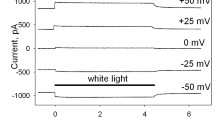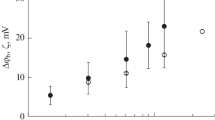Summary
The mechanism by which the light absorption of cyanine and oxonol dyes changes in response to changes in transmembrane electrical potential has been studied. Trains of membrane potential steps produce changes in the intensity of light passing through glycerylmonooleate (GMO) bilayer lipid membranes (BLM) in the presence of these dyes. The size of the signal-averaged absorbance change for one of the cyanine dyes diS-C2-(5) is ∼10−5. The response time for the absorbance change of all of the dyes was ≦10 μsec. In order for an absorption signal to be observed, the concentration of dye on both sides of the membrane must be different. Since GMO bilayer membranes are permeable to the charged dyes that were studied, the dye concentration asymmetry necessary for the optical signal had to be maintained with a constant dc membrane potential, onto which the trains of potential steps were superimposed. The more hydrophobic dyes were the most permeant. Inclusion of cholesterol in the GMO bilayers decreased the permeance of the positively charged cyanine dyes, but increased the permeance of the negatively charged oxonol dyes. The magnitude and the size of the BLM absorbance change depended on the wavelength of illumination. Comparisons of the wavelength dependence of the BLM spectra with absorption difference spectra obtained with model membrane systems allow us to postulate a mechanism for a BLM absorbance change. For the cyanine and oxonol dyes, the data are consistent with an ON-OFF mechanism where a quantity of dye undergoes a rapid potential-dependent movement between a hydrocarbon-like binding site on the membrane and the aqueous salt solution near the membrane. For some dyes, which readily aggregate on the membrane, part of the absorbance change may possibly be explained by a potential dependent change in the state of aggregation of dye molecules localized on the membrane. Mechanisms involving a potential dependent change in the polarizability of the environment of membrane-localized dye molecules cannot be excluded, but seem unlikely.
Similar content being viewed by others
References
Andersen, O.S., Fuchs, M. 1975. Potential energy barriers to ion transport within lipid bilayers.Biophys. J. 15:795
Blaustein, M.P., Goldring, J.M. 1975. Membrane potentials in pinched-off presynaptic nerve terminals monitored with a fluorescent probe: Evidence that synaptosomes have potassium diffusion potentials.J. Physiol. (London) 247:589
Brewer, G. 1976. The state of energization of the membrane ofEscherichia coli as affected by physiological conditions and colicin K.Biochemistry 15:1387
Chance, B., Baltscheffsky, M. 1975. Carotenoid and merocyanine probes in chromatophore membranes.Biomembranes 7:33
Cohen, L.B., Salzberg, B.M., Davila, H.V., Ross, W.N., Landowne, D., Waggoner, A.S., Wang, C.H. 1974. Changes in axon fluorescence during activity: Molecular probes of membrane potential.J. Membrane Biol. 19:1
Conti, F. 1975. Fluorescent probes in nerve membranes.Annu. Rev. Biophys. Bioeng. 4:287
Hoffman, J.F., Laris, P.C. 1974. Determination of membrane potentials in human andAmphiuma red blood cells by means of a fluorescent probe.J. Physiol. (London) 239:519
Kashket, E.R., Wilson, T.H. 1974. Protonmotive force in fermentingStreptococcus lactis 7962 in relation to sugar accumulation.Biochem. Biophys. Res. Commun. 59:879
Ketterer, B., Neumcke, B., Läuger, P. 1971. Transport mechanism of hydrophobic ions through lipid bilayer membranes.J. Membrane Biol. 5:225
Laris, P.C., Bahr, D.P., Chaffee, R.R.J. 1975. Membrane potentials in mitochondrial preparations measured by means of cyanine dye.Biochim. Biophys. Acta 376:415
Laris, P.C., Pershadsingh, H.A. 1974. Estimations of membrane potentials inStreptococcus faecalis by means of a fluorescent probe.Biochem. Biophys. Res. Commun. 57:620
Laris, P.C., Pershadsingh, H.A., Johnstone, R.M. 1976. Monitoring membrane potentials in Ehrlich ascites tumor cells by means of a fluorescent dye.Biochim. Biophys. Acta (in press)
Läuger, P., Neumcke, B. 1973. Theoretical analysis of ion conductance in lipid bilayer membranes.In: Membranes. G. Eisenman, Editor. Vol. 2. Marcel Dekker, New York
Oetliker, H., Baylor, S.M., Chandler, W.K. 1975. Simultaneous changes in fluorescence and optical retardation in single muscle fibers during activity.Nature (London) 257:693
Renthal, R., Lanyi, J.K. 1976. Light-induced membrane potential and pH gradient inHalobacterium halobium envelope vesicles.Biochemistry 15:2136
Ross, W.N., Salzberg, B.M., Cohen, L.B., Davila, H.V. 1974. A large change in dye absorption during the action potential.Biophys. J. 14:983
Ross, W.N., Salzberg, B.M., Cohen, L.B., Grinvald, A., Davila, H.V., Waggoner, A.S., Wang, C.H. 1976. Changes in absorption, fluorescence, dichroism, and birefringence in stained giant axons: Optical measurements of membrane potential.J. Membrane Biol. 33:141
Salama, G., Morad, M. 1976. Merocyanine 540 as an optical probe of transmembrane electrical activity in the heart.Science 191:485
Salzberg, B.M., Cohen, L.B., Ross, W.N., Waggoner, A.S., Wang, C.-H. 1976. New and more sensitive molecular probes of membrane potential: Simultaneous optical recordings from several cells in the central nervous system of the leech.Biophys. J. 16:23a
Salzberg, B.M., Davila, H.V., Cohen, L.B. 1973. Optical recording of impulses in individual neurons of an invertebrate central nervous system.Nature (London) 246:508
Sims, P.J., Waggoner, A.S., Wang, C.-H., Hoffman, J.F. 1974. Studies on the mechanism by which cyanine dyes measure membrane potential in red blood cells and phosphatidylcholine vesicles.Biochemistry 13:3315
Singleton, W.S., Gray, M.S., Brown, M.L., White, J.L. 1965. Chromatographically homogeneous lecithin from egg phospholipids.J. Am. Oil Chem. Soc. 42:53
Szabo, G. 1974. Dual mechanism for the action of cholesterol on membrane permeability.Nature (London) 252:47
Szabo, G. 1976. The influence of dipole potentials on the magnitude and kinetics of ion transport in lipid bilayer membranes.In: Extreme Environment: Mechanisms of Microbial Adaptation. M.R. Heinrich, editor. Academic Press, New York
Vergara, J., Bezanilla, F. 1976. Fluorescence changes during electrical activity in frog muscle stained with merocyanine.Nature (London) 259:684
Waggoner, A.S. 1976. Optical probes of membrane potential.J. Membrane Biol. 27:317
Waggoner, A.S., Sirkin, D., Tolles, R.L., Wang, C.-H. 1975. Rate of membrane penetration of potential-sensitive dyes.Biophys. J. 15:2a
Waggoner, A.S., Wang, C.-H., Tolles, R.L. 1976. Potential dependent absorption changes of cyanine and oxonol dyes on black lipid membranes.Biophys. J. 16:139a
West, W., Geddes, A.L. 1964. The effect of solvents and of solid substrates on the visible molecular absorption spectrum of cyanine dyes.J. Phys. Chem. 68:837
West, W., Pearce, S. 1965. The dimeric state of cyanide dyes.J. Phys. Chem. 69:1894
Author information
Authors and Affiliations
Rights and permissions
About this article
Cite this article
Waggoner, A.S., Wang, C.H. & Tolles, R.L. Mechanism of potential-dependent light absorption changes of lipid bilayer membranes in the presence of cyanine and oxonol dyes. J. Membrain Biol. 33, 109–140 (1977). https://doi.org/10.1007/BF01869513
Received:
Revised:
Issue Date:
DOI: https://doi.org/10.1007/BF01869513




